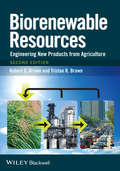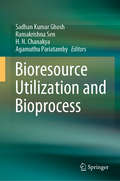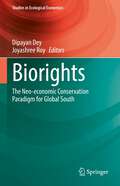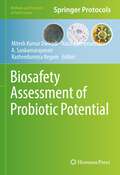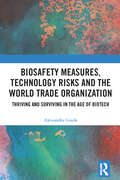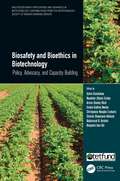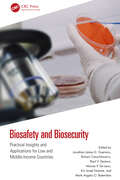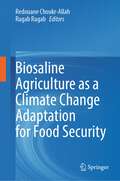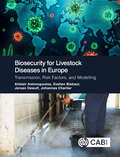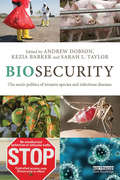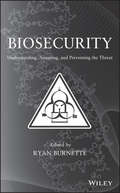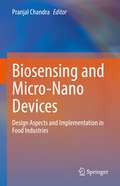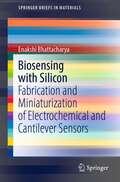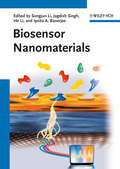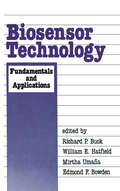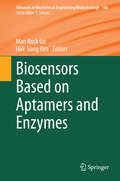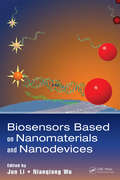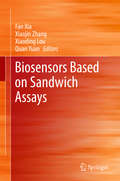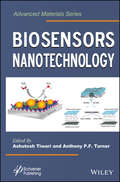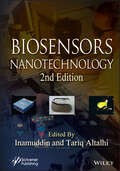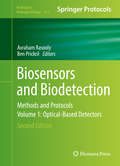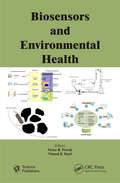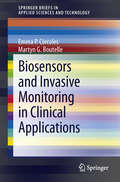- Table View
- List View
Biorenewable Resources
by Robert C. Brown Tristan R. BrownBiorenewable Resources: Engineering New Products from Agriculture, 2nd Edition will provide comprehensive coverage of engineering systems that convert agricultural crops and residues into bioenergy and biobased products. This edition is thoroughly updated and revised to better serve the needs of the professional and research fields working with biorenewable resource development and production. Biorenewable resources is a rapidly growing field that forms at the interface between agricultural and plant sciences and process engineering. Biorenewable Resources will be an indispensable reference for anyone working in the production of biomass or biorenewable resources.
Bioresource Utilization and Bioprocess
by Sadhan Kumar Ghosh Agamuthu Pariatamby Ramakrishna Sen H. N. ChanakyaThis book focuses on the utilization of bio-resources and their conversion pathways for a sustainable future. Tapping into bio-resources by means of thermochemical and biochemical processes has attracted researchers from all over the world; it is a broad area that has given birth to concepts like the biorefinery, as well as a new stream known as biotechnology. Its scope includes biochemical and microbiological engineering, biocatalysis and biotransformation, biosynthesis and metabolic engineering, bioprocess and biosystem engineering, bioenergy and biorefineries, cell culture and biomedical engineering, food, agricultural and marine biotechnology, bioseparation and biopurification engineering, bioremediation and environmental biotechnology, etc. The book discusses a host of new technologies now being used to tap these resources with innovative bioprocesses. All chapters are based on outstanding research papers selected for and presented at the IconSWM 2018 conference.
Biorights: The Neo-economic Conservation Paradigm for Global South (Studies in Ecological Economics #7)
by Joyashree Roy Dipayan DeyThis book evaluates local conservation successes of global south in the climate milieu, as an empirical evidence of ‘Bio-rights’ of commons at community-ecosystem interface for sustainable intensification of nature’s goods and services. Bio-rights is a right-based neo-economic conservation paradigm that compensates the opportunity costs incurred in conservation efforts by the marginal communities, living near globally important ecosystems and dependent on it for their livelihood, through payments from environment services. The book would bring forth the true value of circular economic interventions in socio-ecological conservation, shaped through sustainable human interactions with nature. This multilevel study of conservation science serves an interdisciplinary academia, consistent with conventions on climate change, bio-diversity and sustainable development, to establish links between conservation priorities and development objectives. Herein, Bio-rights is introduced as a ‘design approach’ for production linked sustainable development, supplemented with case studies from the east.
Biosafety Assessment of Probiotic Potential (Methods and Protocols in Food Science)
by A. Sankaranarayanan Natarajan Amaresan Mitesh Kumar Dwivedi Rasheedunnisa BegumThis volume provides methods on procedures for assessing the biosafety aspects of probiotics. Chapters are divided into five parts detailing in vitro biosafety assessment, biogenic amine production, D-lactic acid production, toxin production, production of various enzymes, determination of toxicity, mutagenicity, virulence genes, capsule formation, hemolytic activity, DNAse activity, bile salt deconjugation, antibiotic resistance, antibiotic resistance gene transfer, mucin degradation, platelet aggregation, and in vivo biosafety assessment of probiotics including determination of infectivity, reproductive and developmental toxicity, and evaluation of immunological parameters in animal models. Authoritative and cutting-edge, Biosafety Assessment of Probiotic Potential aims to be a foundation for future studies and to be a source of inspiration for new investigations in the field.
Biosafety Measures, Technology Risks and the World Trade Organization: Thriving and Surviving in the Age of Biotech
by Alessandra GuidaThis book examines the work of the World Trade Organization (WTO), with a focus on the capacity of its judiciary to strike a reasoned balance between free trade in biotechnology and biosafety as to promote the 2030 Agenda for Sustainable Development and its Sustainable Development Goals. By adopting an innovative interpretation of the precautionary principle and proportionality analysis, the work offers normative suggestions to develop what the author terms “a constructive bridge of knowledge” between decision-makers, scientists, social experts and expert witnesses, which can support a judicial balance by design rather than by chance. Biotechnology is sometimes regarded as a panacea for modern-day challenges, such as feeding a growing world population and counteracting climate-change problems, and a means of offering significant economic opportunities. However, biotechnology can present uncertain, though serious, risks to human health and the environment (i.e., biosafety). Trading biotech products magnifies these risks and benefits globally. This book explores the topical, though still underexplored, question of how to find a point of equilibrium between the revolutionary advancement offered by technology and the need to safeguard biosafety from uncertain, though potentially irreversible, technology risks. It offers a thorough analysis of normative, judicial and epistemic issues hindering a reasoned balance between trade and non-trade interests under the WTO. The work offers practical relevance for the resolution of legal disputes in contexts of uncertainty, as well as innovative theoretical contributions. It will be a valuable resource for policymakers working on precautionary governance and management, scholars in the areas of trade law, human rights law and environmental law, law students and practitioners, as well as NGOs working in the field of new technologies, biosafety, sustainability and food safety.
Biosafety and Bioethics in Biotechnology: Policy, Advocacy, and Capacity Building (Multidisciplinary Applications and Advances in Biotechnology)
by Sylvia UzochukwuThis book covers a range of important topics in biotechnology policy, advocacy and education, bioethics, biosafety regulations for genetically modified organisms and gene-edited products and biotechnology manpower development. Throughout the book, the contributors review biosafety and bioethical guidelines that could enhance adoption of biotechnology in alignment with national priorities and research agendas. They also discuss the importance of current biotechnology policy advocacy, enlightenment and public engagement with stakeholders and policy makers. The book will be useful reference material for scientists and researchers working in the fields of food and agricultural biotechnology, biopharmaceuticals and medical biotechnology, environmental biotechnology, biotechnology policy and advocacy, biotechnology communication and manpower development, biosafety and bioethics, etc. Emphasizes recent advances in biotechnology that could ameliorate the high-level global food insecurity through the deployment of the technology in Nigeria Provides detailed information on how to domesticate biotechnology and boost training of the biotechnology workforce in the universities and research institutes Introduces new frontiers in the area of organizing informal biotechnology capacity building courses and professional certification Reviews biosafety and bioethical guidelines that could enhance adoption of biotechnology in alignment with national priorities and research agendas Discusses current biotechnology policy advocacy, enlightenment and public engagement with stakeholders and policy makers Sylvia Uzochukwu, Ph.D., is a Professor of Food Science and Biotechnology, and Director, Biotechnology Centre, Federal University, Oye-Ekiti, Nigeria. Arinze Stanley Okoli, Ph.D., is an Associate Professor at Genoek – Centre for Biosafety, Universitetet II, Breivika, Tromsoe, Norway. Nwadiuto (Diuoto) Esiobu, Ph.D., is a Professor of Microbiology and Biotechnology at Florida Atlantic University, Boca Raton, FL, USA, and the President and Founder of Applied Biotech, Inc. and ABINL. Emeka Godfrey Nwoba, Ph.D., is currently at the Algae Research & Development Centre, Murdoch University, Western Australia. Christpeace Nwagbo Ezebuiro, Ph.D., is a Project Manager, Renewable Energy Expert and Head of Clean Technology Division at the National Biotechnology Development Agency, Abuja, Nigeria. Charles Oluwaseun Adetunji, Ph.D., is an Associate Professor of Microbiology and Biotechnology and the Director of Intellectual Property and Technology Transfer, Edo State University Uzairue, Nigeria. Abdulrazak B. Ibrahim, Ph.D., is a Capacity Development Expert at the Forum for Agricultural Research in Africa (FARA) and Associate Professor of Biochemistry, Ahmadu Bello University, Zaria, Nigeria. Benjamin Ewa Ubi, Ph.D., is a Professor of Plant Breeding and Biotechnology and Director, Biotechnology Research and Development Centre, Ebonyi State University Abakaliki, Nigeria.
Biosafety and Biosecurity: Practical Insights and Applications for Low and Middle-Income Countries
by Jonathan Jaime G. Guerrero, Rohani Cena-Navarro, Raul V. Destura, Marian P. De Leon, Kin Israel R. Notarte, and Mark Angelo O. BalendresThere are many guidelines, protocols and advisories that outline how biosafety and biosecurity can be adopted by institutions around the world. Whilst helpful, many of these are tailored to affluent Western nations. This leaves developing nations far behind since their laboratories and institutions are resource-scarce and biosafety and biosecurity are not mainstreamed entirely among the different laboratory workers, healthcare professionals, researchers, and academics. Biosafety and Biosecurity: Practical Insights and Applications for Low and Middle-Income Countries aims to bridge this gap by comprehensively summarizing the state and development of biosafety and biosecurity in developing and developed nations in a comparative analysis. This book includes basic concepts and principles of biosafety and biosecurity, including certification and legal frameworks, both international and local, and biosafety and biosecurity across disciplines including environmental, medical, and special topics that are relevant to countries with comparable conditions. This proposed book solves the problem of the lack of a prescribed professional title that comprehensively summarizes the state and development of biosafety and biosecurity throughout the world, allowing the reader a 360 view of the subject area.This book will appeal to a global audience of biorisk officers, health and safety professionals and specialists in the life sciences, health and allied fields, environmental science, engineering, and plant and animal agriculture.
Biosaline Agriculture as a Climate Change Adaptation for Food Security
by Ragab Ragab Redouane Choukr-AllahThis book presents recent research work on Biosaline Agriculture presented during First International Forum on Biosaline Agriculture in Laayoune, Morocco from May 3rd to May 4th 2019. The aim of this book is to showcase the global potential of Biosaline agriculture, provide an update on the development of recent innovations in the field of Biosaline agriculture, the best management practices to safely use brackish and saline water, highlight the use of non-conventional water in marginal environment production and the current advanced technologies of desalination of brackish and seawater. The different chapters will also discuss solutions that are adapted to local conditions as part of a sustainable development perspective. The book provides up-to-date technical and scientific data on growing crops under marginal environment so as to encourage the dissemination of this knowledge in the best practices to increase the productivity in Biosaline agriculture, in view of the potential to contribute to food security. The book is expected to stimulate interest in the non-conventional water resources and crops among junior and senior researchers and among those who are increasingly focused on exploiting marginal environments. It will also be of interest to decision-makers and the public and private sectors to jointly address the issues of food security especially of the poor and vulnerable people living in marginal environments worldwide by providing innovative technology transfer.
Biosecurity for Livestock Diseases in Europe: Transmission, Risk Factors, and Modelling
by Jeroen Dewulf Dr Alistair Antonopoulos Evelien Biebaut Johannes CharlierBiosecurity practices can help prevent the introduction and spread of disease, promoting better animal health and welfare, human health, food safety, and the economic benefits of livestock production. Stemming from a joint initiative between the Biosecure project which brought together 17 partners across 12 European countries, and DISCONTOOLS, the research gap database in animal health, this book provides valuable background information which can help to better understand and prioritize biosecurity measures. Driven by an evidence-based and cost-effective approach to biosecurity, it is divided into two sections covering endemic diseases typically present within most countries, and epidemic diseases with the potential for large scale outbreaks. Through a series of disease entries, it: - introduces the diseases of most relevance for the European context; - reviews our current understanding of biosecurity throughout the livestock production chain, and across the principal terrestrial animal species farmed within Europe: poultry, swine, cattle, and small ruminants; - covers the prevalence, risk factors, transmission routes, current control measures and biosecurity, and data for transmission modelling for each disease. By summarizing current knowledge on a range of diseases, this book forms both a useful resource for researchers and professionals in animal disease prevention, and a starting off point for identifying information gaps and requirements for future research.
Biosecurity in Animal Production and Veterinary Medicine: From principles to practice
by Jeroen Dewulf Filip Van ImmerseelGlobally, the way the animal production industry copes with infectious diseases is changing. The (excessive) use of antimicrobials is under debate and it is becoming standard practice to implement thorough biosecurity plans on farms to prevent the entry and spread of pathogenic micro-organisms. Not only in farm animal production, but also in facilities where companion animals are kept, including in veterinary practices and clinics, awareness of the beneficial implications of a good biosecurity plan has raised. The book Biosecurity in Animal Production and Veterinary Medicine is the first compilation of both fundamental aspects of biosecurity practices, and specific and practical information on the application of the biosecurity measures in different animal production and animal housing settings. The book starts with a general introductory chapter on the epidemiology of infectious diseases, followed by a chapter explaining the general principles of biosecurity. Specific topics of biosecurity, including rodent and insect control, cleaning and disinfection, hygiene and decontamination of feed, drinking water and air, and measuring the biosecurity status of farms, are detailed in dedicated chapters. Explanations on the relevance of the implementation of biosecurity plans in order to improve animal health and performance and reduce antimicrobial usage are described, and a chapter on ways to motivate farmers to implement a biosecurity plan has been included. Practical chapters deal with biosecurity in the poultry, pig and cattle industry, horse facilities, dog kennels, veterinary practices and clinics and laboratory animal facilities. The book is a practical guide that can be used by farm and animal facility managers, consultants, veterinarians, animal caretakers, and people with an interest in prevention of diseases in animals. Academics and students will benefit from the book because it contains all relevant information on animal biosecurity.
Biosecurity: The Socio-Politics of Invasive Species and Infectious Diseases (Routledge Environment And Sustainability Handbooks Ser.)
by Andrew Dobson Kezia Barker Sarah L. TaylorBiosecurity is the assessment and management of potentially dangerous infectious diseases, quarantined pests, invasive (alien) species, living modified organisms, and biological weapons. It is a holistic concept of direct relevance to the sustainability of agriculture, food safety, and the protection of human populations (including bio-terrorism), the environment, and biodiversity. Biosecurity is a relatively new concept that has become increasingly prevalent in academic, policy and media circles, and needs a more comprehensive and inter-disciplinary approach to take into account mobility, globalisation and climate change. In this introductory volume, biosecurity is presented as a governance approach to a set of concerns that span the protection of indigenous biological organisms, agricultural systems and human health, from invasive pests and diseases. It describes the ways in which biosecurity is understood and theorized in different subject disciplines, including anthropology, political theory, ecology, geography and environmental management. It examines the different scientific and knowledge practices connected to biosecurity governance, including legal regimes, ecology, risk management and alternative knowledges. The geopolitics of biosecurity is considered in terms of health, biopolitics and trade governance at the global scale. Finally, biosecurity as an approach to actively secure the future is assessed in the context of future risk and uncertainties, such as globalization and climate change.
Biosecurity: Understanding, Assessing, and Preventing the Threat
by Ryan BurnetteLearn how to assess and prevent biosecurity threats to protect public health and national securityWith contributions from experts in all facets of biosecurity, this book explains the fundamental elements of biosecurity as well as the related concepts of biosafety and biosurety, detailing how all three concepts fit within the framework of biodefense. Readers are then given the tools needed to assess and prevent biosecurity threats and vulnerabilities. The book explores the nature of biosecurity threats to research laboratories as well as to agriculture, food, and mass transit. Moreover, readers will learn how to apply principles of biosecurity to assess epidemics and protect public health.Biosecurity takes a detailed look at today's biosecurity policy, explaining how it is likely to evolve given current and potential threats to national security. The authors stress the importance of education and advocacy, helping readers develop effective programs to build public awareness and preparedness. The book also presents a novel tool to assess the effectiveness of laboratory biosafety and biosecurity programs.Biosecurity is divided into four parts:Part I: An Introduction to BiosecurityPart II: Elements of BiosecurityPart III: Biosecurity in Various SectorsPart IV: Biosecurity Policy, Bioterrorism, and the FutureThis book will instill a deep understanding of what biosecurity is and what it is not. It urges readers to think about the importance of biosecurity as it relates to national security, safety, and health. By exposing major flaws in global biosecurity thinking, Biosecurity sets forth a clear pathway to correct those errors and build stronger biosecurity programs.
Biosensing and Micro-Nano Devices: Design Aspects and Implementation in Food Industries
by Pranjal ChandraThis book reviews applications of nanomaterial and nanodevices in the food industry. It also discusses the advanced bioanalytical techniques, including Enzyme-Linked Immunosorbent Assay (ELISA), immunoanalytical techniques, and monoclonal antibody-based immunological techniques for detecting food adulterations and allergens. It comprehensively covers electrode modification and nano-engineered fabrication of biosensors to enhance their functionalities for utilization in food industries. The book highlights the utilization of nanobiosensors for food safety and quality analysis, such as detection of toxin, food-borne pathogen, allergen, evaluation of toxicity etc. Further, it also summarizes the recent advances in nanodevices such as nano-systems, nano-emulsions, nanopesticides, and nanocapsules and their applications in the food industry. Lastly, it covers nanomaterial-based sensors for drug analysis in diverse matrices. It serves as an invaluable source of information for professionals, researchers, academicians, and students related to food science and technology.
Biosensing with Silicon: Fabrication and Miniaturization of Electrochemical and Cantilever Sensors (SpringerBriefs in Materials)
by Enakshi BhattacharyaThis book discusses two silicon biosensors: an electrochemical sensor – the Electrolyte Insulator Silicon Capacitor (EISCAP), and a mechanical resonant cantilever sensor. The author presents the principle and the technology behind the device fabrication and miniaturization, stable and reproducible functionalization protocols for bioreceptor immobilization, and the measurement and the data analysis for extracting the best performance from these sensors.EISCAP sensors, used for the estimation of triglycerides and urea, have been improved through the use of micromachining processes. The miniaturization brought out advantages as well as challenges which are discussed in this book, resulting in a prototype mini-EISCAP with a readout circuit for fast and accurate estimation of triglycerides. The author also reports on the sensitivity improvements in the estimation of triglycerides and urea obtained with the polycrystalline silicon cantilever and its measurements in liquid media.The book is ideal for materials scientists and engineers working in the field of biosensors and MicroElectroMechanical systems (MEMS) and their optimizations, as well as researchers with biochemical or biomedical expertise, in order to have a fresh and updated review on the last progresses reached with EISCAPs and cantilever sensors.
Biosensor Nanomaterials
by Songjun Li Jagdish Singh He Li Ipsita A. BanerjeeBiosensors are devices that detect the presence of microbials such as bacteria, viruses or a range biomolecules, including proteins, enzymes, DNA and RNA. For example, they are routinely applied for monitoring the glucose concentration in blood, quality analysis of fresh and waste water and for food control. Nanomaterials are ideal candidates for building sensor devces: where in just a few molecules can alter the properties so drastically that these changes may be easily detected by optical, electrical or chemical means. Recent advantages have radically increased the sensitivity of nanomaterial-based biosensors, making it possible to detect one particular molecule against a background of billions of others. Focusing on the materials suitable for biosensor applications, such as nanoparticles, quantum dots, meso- and nanoporous materials and nanotbues, this text enables the reader to prepare the respective nanomaterials for use in actual devices by appropriate functionalization, surface processing or directed self-assembly. The emphasis throughout is on electrochemical, optical and mechancial detection methods, leading to solutions for today's most challenging tasks. The result is a reference for researchers and developers, disseminating first-hand information on which nanomaterial is best suited to a particular application - and why.
Biosensor Technology: Fundamentals and Applications
by BuckThis authoritative reference covers recent advances in the field, stressing an interdisciplinaryapproach to the development and use of biosensor technology in physics,engineering, analytical chemistry, and biochemistry (including immunochemistry).about the editors ...RICHARD P. BucK is a Professor in the Chemistry Department, University of Northcarolina, Chapel Hill. Professor Buck serves on the editorial boards of severaljournals including Analytical Instrumentation: Applications and Designs for Chemica~Biomedica~ and Environmental Science (Marcel Dekker, Inc.). He is a member of theAmerican Chemical Society, Electrochemical Society, and International Society ofElectrochemistry. He received the B.S. (1950) and M.S. (1951) degrees from thecalifornia Institute of Tochnology, Pasadena, and Ph.D. degree (1954) from theMassachusetts Institute of Tochnology, cambridge.W1WAM E. HATFIELD is Mary Ann Smith Professor and Vice Chairman of Chemistry,and Acting Chairman of the Curriculum in Applied Sciences, University of Northcarolina, Chapel Hill. He is the author or coauthor of over 300 publications, andcoeditor, with John H. Miller, Jr., of High-Temperature Superconducting Materials:Preparations, Properties, and Processing (Marcel Dekker, Inc.). He is a member of theAmerican Chemical Society, American Association for the Advancement of Science,and Materials Research Society. He received the B.S. (1958) and M.S. (1959) degreesfrom Marshall University, Huntington, West Virginia, Ph.D. degree (1962) from theUniversity of Arizona, Tucson, and completed postdoctoral research at the Universityof Illinois, Urbana.M1KTHA UMANA is an independent consultant to Glaxo Inc. and Research 'IriangleInstitute, Research 'Iriangle Park, and Duke University Engineering Research Center,Durham, North carolina. The coauthor of numerous scientific journal articles, herresearch interests include surface chemistry, electrochemistry, and biosensors. Shereceived the B.Sc. degree (1969) from the University of Chile, Santiago, and Ph.D.degree (1972) from the University of London, England.EDMOND E BowoEN is an Associate Professor in the Department of Chemistry andin the Biotechnology Program, North carolina State University, Raleigh. Thecoauthor of numerous journal articles, his research interests include bioelectrochemistry,biological electron transfer, biosensors, and surface chemistry. He receivedthe B.S. degree (1970) from Syracuse University, Syracuse, New York, and Ph.D.degree (1982) from Virginia Commonwealth University, Richmond.
Biosensors Based on Aptamers and Enzymes (Advances in Biochemical Engineering/Biotechnology #140)
by Man Bock Gu Hak-Sung KimVolumes are organized topically and provide a comprehensive discussion of developments in the respective field over the past 3-5 years. The series also discusses new discoveries and applications. Special volumes are dedicated to selected topics which focus on new biotechnological products and new processes for their synthesis and purification. In general, special volumes are edited by well-known guest editors. The series editor and publisher will however always be pleased to receive suggestions and supplementary information. Manuscripts are accepted in English.
Biosensors Based on Nanomaterials and Nanodevices (Nanomaterials and their Applications)
by AntonioBiosensors Based on Nanomaterials and Nanodevices links interdisciplinary research from leading experts to provide graduate students, academics, researchers, and industry professionals alike with a comprehensive source for key advancements and future trends in nanostructured biosensor development. It describes the concepts, principles, materials, device fabrications, functions, system integrations, and applications of various types of biosensors based on signal transduction mechanisms, including fluorescence, photonic crystal, surface-enhanced Raman scattering, electrochemistry, electro-luminescence, field-effect transistor, and magnetic effect. The book: Explains how to utilize the unique properties of nanomaterials to construct nanostructured biosensors to achieve enhanced performance Features examples of biosensors based on both typical and emerging nanomaterials, such as gold nanoparticles, quantum dots, graphene, graphene oxides, magnetic nanoparticles, carbon nanotubes, inorganic nanowires/nanorods, plasmonic nanostructures, and photonic crystals Demonstrates the broad applications of nanostructured biosensors in environmental monitoring, food safety, industrial quality assurance, and in vitro and in vivo health diagnosis Inspires new ideas for tackling multiscale and multidisciplinary issues in developing high-performance biosensors for complex practical biomedical problems Focusing on the connection between nanomaterials research and biosensor development, Biosensors Based on Nanomaterials and Nanodevices illustrates the exciting possibilities and critical challenges of biosensors based on nanomaterials and nanodevices for future health monitoring, disease diagnosis, therapeutic treatments, and beyond.
Biosensors Based on Sandwich Assays
by Fan Xia Xiaojin Zhang Xiaoding Lou Quan YuanThis book shows the various sandwich assays that are constructed from recognition molecules, such as antibodies, oligonucleotide sequences and aptamers, developed as a result of nano- and biotechnology advances. It consists of ten chapters presenting interesting examples of these assays, organized according to the type of analytic methods (colorimetric, fluorescence, electrochemical, etc. ) and detected objects (protein, nucleic acid, small-molecule, ion, etc. ). It also includes a chapter discussing the introduction of sandwich assays as biosensors for the detection of a range of targets. It is an interesting and useful resource for a wide readership in various fields of chemical science and nanotechnology.
Biosensors Nanotechnology
by Ashutosh Tiwari Anthony P.F. TurnerA new emerging field that combines nanoscale materials and biosensor technology is receiving increased attention. Nanostructures have been used to achieve direct wiring of biosensing elements to electrode surfaces, to promote bio-reactions, to impose nanobarcodes on biomaterials, and to amplify the signal from bio-recognition events. Nanomaterials based biosensors have found wide spread applications in the environmental and medical applications for their sensitivity, specificity, rapidity, simplicity, and cost-effectiveness. In the same pursuit, Biosensors Nanotechnology provides detailed review chapters on a range of nanostructures such as nanoparticles, nanowires, nanotubes, nanoribbons, nanorods, nanobelts and nanosheets in the construction of biosensors with set applications of biosensors nanotechnology for biological and chemical analyses, food safety industry, biomedical diagnostics, clinical detection, and environmental monitoring. The senior contributors write on the following topics: ZnO and graphene microelectrode applications in biosensing Assembly of polymers/metal nanoparticles Gold nanoparticle-based electrochemical biosensors Impedimetric DNA sensing employing nanomaterials Graphene and carbon nanotube based biosensors The-state-of-art of nanomedicine Computational nanochemistry study BFPF green fluorescent protein chromophore Biosynthesis of metal nanoparticles Ionic discotic liquid crystals Role of advanced materials as nanosensors in water treatment Bioconjugated-nanoporous gold films in electrochemical biosensors Combination of molecular imprinting and nanotechnology Recent development of fiber reinforced composite materials Principal and properties of multiferroics and ceramics
Biosensors Nanotechnology
by Inamuddin Tariq AltalhiBIOSENSORS NANOTECHNOLOGY The second edition of Biosensors Nanotechnology comprises 20 chapters and discusses a wide range of applications exploited by biosensors based on nanoparticles including new domains of bionics, power production and computing. The biosensor industry began as a small, niche activity in the 1980s and has since developed into a large, global industry. Nanomaterials have substantially improved not only non-pharmaceutical and healthcare uses, but also telecommunications, paper, and textile manufacturing. Biological sensing assists in the understanding of living systems and is used in a variety of sectors, including medicine, drug discovery, process control, environmental monitoring, food safety, military and personal protection. It allows for new opportunities in bionics, power generation and computing, all of which will benefit from a greater understanding of the bio-electronic relationship, as advances in communications and computational modeling enable us to reconsider how healthcare is offered and R&D and manufacturing are enhanced. In this fast-evolving discipline, the combination of nanoscale materials with biosensor technology has gained a lot of traction. Nanostructures have been used to increase the adherence of biosensor materials to electrode surfaces, print nano barcodes on biomaterials, increase the pace of bio-responses, and amplify the electric signal. Some of the topics discussed in the book include: Bioreceptors for Cells; Bioreceptors for Enzymatic Interactions; Dendrimer-Based Nanomaterials for Biosensors; Biosensors in 2D Photonic Crystals; Bioreceptors for Affinity Binding in Theranostic Development; Biosensors for Glucose Monitoring; Metal-Free Quantum Dots-Based Nanomaterials for Biosensors; Bioreceptors for Microbial Biosensors; Plasmonic Nanomaterials in Sensors; Magnetic Biosensors; Biosensors for Salivary Biomarker Detection of Cancer and Neurodegenerative Diseases; Design and Development of Fluorescent Chemosensors for the Recognition of Biological Amines and Their Cell Imaging Studies; Application of Optical Nanoprobes for Supramolecular Biosensing; In Vivo Applications for Nanomaterials in Biosensors; Biosensor and Nanotechnology for Diagnosis of Breast Cancer; Bioreceptors for Antigen–Antibody Interactions; Biosensors for Paint and Pigment Analysis; Bioreceptors for Tissue; Biosensors for Pesticide Detection; and Advances in Biosensor Applications for Agroproducts Safety. Audience The book is written for a large and broad readership including researchers, industry engineers, and university graduate students from diverse backgrounds such as chemistry, materials science, physics, pharmacy, medical science, biomedical engineering, electronics engineering, and nanotechnology.
Biosensors and Biodetection: Methods and Protocols Volume 1: Optical-Based Detectors (Methods in Molecular Biology #1571)
by Avraham Rasooly Ben PrickrilThis volume provides comprehensive and detailed technical protocols on current biosensor and biodetection technologies and examples of their applications and capabilities. Chapters in Biosensors and Biodetection: Methods and Protocols, Volume 1: Optical-Based Detectors, Second Edition chapters focus on direct and indirect optical detectors including surface plasmon resonance, interferometric sensors, charge-coupled device (CCD) based detectors, spectrometry, and many other cutting-edge optical biosensors technologies. Written in the format of the highly successful Methods in Molecular Biology series, chapters include introductions to their respective topics, lists of the necessary materials and reagents, tips on troubleshooting and avoiding known pitfalls, and step-by-step, readily reproducible laboratory protocols. Authoritative and practical, Biosensors and Biodetection: Methods and Protocols, Volume 1: Optical-Based Detectors, Second Edition offers descriptions of major technologies by leading experts in the field in extensive technical detail. The aim of the book is to make biosensors more accessible and understandable to engineers, students, medical professionals, molecular biologists, chemical, and physical science researchers developing biosensor technologies, allowing readers to both understand the technology and to construct similar devices.
Biosensors and Biodetection: Methods and Protocols, Volume 2: Electrochemical, Bioelectronic, Piezoelectric, Cellular and Molecular Biosensors (Methods in Molecular Biology #1572)
by Avraham Rasooly Ben PrickrilThis volume provides comprehensive and detailed technical protocols on current biosensor and biodetection technologies and examples of their applications and capabilities. Chapters in Biosensors and Biodetection: Methods and Protocols, Volume 1: Optical-Based Detectors, Second Edition chapters focus on direct and indirect optical detectors including surface plasmon resonance, interferometric sensors, charge-coupled device (CCD) based detectors, spectrometry, and many other cutting-edge optical biosensors technologies. Written in the format of the highly successful Methods in Molecular Biology series, chapters include introductions to their respective topics, lists of the necessary materials and reagents, tips on troubleshooting and avoiding known pitfalls, and step-by-step, readily reproducible laboratory protocols. Authoritative and practical, Biosensors and Biodetection: Methods and Protocols, Volume 1: Optical-Based Detectors, Second Edition offers descriptions of major technologies by leading experts in the field in extensive technical detail. The aim of the book is to make biosensors more accessible and understandable to engineers, students, medical professionals, molecular biologists, chemical, and physical science researchers developing biosensor technologies, allowing readers to both understand the technology and to construct similar devices.
Biosensors and Environmental Health
by Victor R. Preedy Vinood B. PatelDiscussing the role biosensors play in detecting and monitoring environmental substances, Biosensors and Environmental Health provides key facts that can be applied to other areas of health and disease and a "mini-dictionary" of key terms and summary points. It covers personal toxicity testing, soil and risk assessment, pesticide, insecticides, par
Biosensors and Invasive Monitoring in Clinical Applications (SpringerBriefs in Applied Sciences and Technology)
by Martyn G. Boutelle Emma P. CórcolesThis volume examines the advances of invasive monitoring by means of biosensors and microdialysis. Physical and physiological parameters are commonly monitored in clinical settings using invasive techniques due to their positive outcome in patients' diagnosis and treatment. Biochemical parameters, however, still rely on off-line measurements and require large pieces of equipment. Biosensing and sampling devices present excellent capabilities for their use in continuous monitoring of patients' biochemical parameters. However, certain issues remain to be solved in order to ensure a more widespread use of these techniques in today's medical practices.
